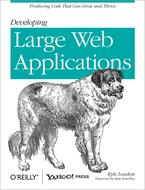Copy Design
- Tenet 1
- Large web applications are built from modular components that are highly reusable, maintainable, and reliable.
Tenet 2
The use of object orientation in JavaScript and server-side scripting languages improves reusability, maintainability, and reliability in large web applications by promoting modularity.
Tenet 3
Large-scale HTML is semantic, devoid of presentation elements other than those inherent in the information architecture, and pluggable into a wide variety of contexts in the form of easily identifiable sections.
Tenet 4
Large-scale CSS forms a layer of presentation that is separate from the information architecture, applied in a modular fashion, and free of side effects as we reuse modules in various contexts.
Tenet 5
Large-scale JavaScript forms a layer of behavior applied in a modular and object-oriented fashion that prevents side effects as we reuse modules in various contexts.
Tenet 6
Dynamic data exchanged between the user interface and the backend is managed through a clearly defined data interface. Pages define a single point for loading data and a single point for saving it.
Tenet 7
Pages are constructed from highly reusable modules that encapsulate everything required (e.g., HTML, CSS, JavaScript, and anything else) to make each module an independently functioning and cohesive unit that can be used in a variety of contexts across various pages.
Tenet 8
Large-scale Ajax is portable and modular, and it maintains a clear separation between data changes and updates to a presentation. Data exchange between the browser and server is managed through a clearly defined interface.
Tenet 9
Large-scale HTML, JavaScript, CSS, and PHP provide a good foundation on which to build large web applications that perform well. They also facilitate a good environment for capturing site metrics and testing.
Tenet 10
The organization of files on the server for a large web application reflects the architecture of the application itself, including clearly demarcated scopes in which each file will be used.
Bibliographical Information
By: Kyle Loudon
Publisher: O'Reilly Media, Inc.
Pub. Date: March 8, 2010
Print ISBN-13: 978-0-596-80302-5
Pages in Print Edition: 304
These are notes I made after reading this book. See more book notes
